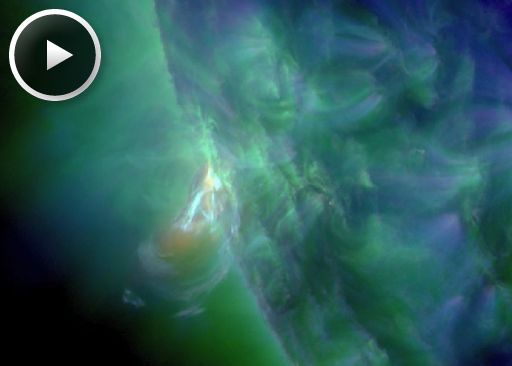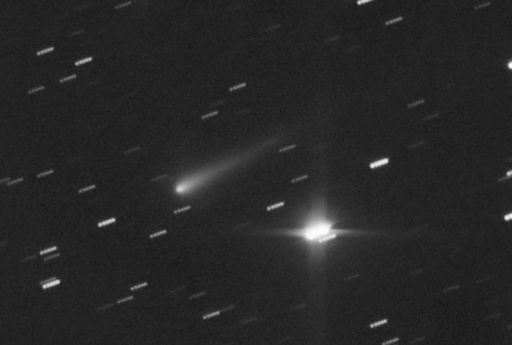HARVEST MOON TONIGHT: Tonight's full Moon is the "Harvest Moon," the full Moon closest to the autumnal equinox. Look for it rising in the east at sunset. Swollen by the Moon illusion and reddened by the effect of low-hanging clouds, the rising Harvest moon is often likened to a "Great Pumpkin." Get the full story and a video from Science@NASA.
AWAKENING SUN: After a week of deep quiet, the drowsy sun is waking up. Five new sunspots were numbered on Sept. 17th as the sun hurled a series of CMEs (movie) into space, none Earth directed. One of the new sunspots, AR1486, is crackling with C-class solar flares. NASA's Solar Dynamics Observatory recorded this C3-flare during the early hours of Sept.18th:
So far, the flares coming from AR1846 are relatively minor C-class events. The active region might be capable of more potent flares. We don't know yet, though, because the foreshortening of AR1846 near the sun's limb prevents a full evaluation of its magnetic field, where the energy for flares is stored. Stay tuned for updates. Solar flare alerts: text, voice.
Realtime Space Weather Photo Gallery
COMET ISON: Comet ISON is still more than two months away from its spectacular close encounter with the sun. Amateur astronomers aren't waiting. The brightening comet has become a good target for backyard telescopes in the pre-dawn sky and pictures of the comet are pouring in. Last night, Chris Schur captured this image from his home observatory in Payson, Arizona:
"This 25 minute exposure shows the comet through a 12 inch telescope," says Schur. "The image has sharp focus, perfect tracking and the star trails are unbroken and smooth. A nearby star added to the nice composition."
At the moment, ISON is too dim for the naked eye--"I estimate the comet's magnitude to be +12.5," says Schur--but it is on track to become an impressive sungrazer. For comparison, Comet ISON is brighter than Comet Lovejoy was in 2011 at a similar distance from the sun. The fact that Comet Lovejoy turned into a spectacular sungrazer bodes well for the performance of Comet ISON.
Observers of Comet ISON will notice that it is in the same part of the sky as Mars. The comet will make a close approach to the Red Planet on October 1st, and during that time Mars satellites will be taking ISON's picture at point blank range. Those images will likely rival or improve upon the view from Earth. Stay tuned to the Comet ISON Photo Gallery for updates from both planets.

Solar wind
speed: 562.2 km/sec
density: 2.6 protons/cm3
explanation | more data
Updated: Today at 2307 UT
X-ray Solar Flares
6-hr max: B5 1830 UT Sep18
24-hr: C3 0315 UT Sep18
explanation | more data
Updated: Today at: 2300 UT
![]()
Daily Sun: 18 Sep 13
The Earthside of the sun is very quiet. Solar activity remains low. Credit: SDO/HMI
![]()
Sunspot number: 80
What is the sunspot number?
Updated 18 Sep 2013
Spotless Days
Current Stretch: 0 days
2013 total: 0 days (0%)
2012 total: 0 days (0%)
2011 total: 2 days (<1%)
2010 total: 51 days (14%)
2009 total: 260 days (71%)
Since 2004: 821 days
Typical Solar Min: 486 days
Update 18 Sep 2013
The Radio Sun
10.7 cm flux: 99 sfu
explanation | more data
Updated 18 Sep 2013
![]()
Current Auroral Oval:
Switch to: Europe, USA, New Zealand, Antarctica
Credit: NOAA/POES
![]()
Planetary K-index
Now: Kp= 2 quiet
24-hr max: Kp= 2 quiet
explanation | more data
Interplanetary Mag. Field
Btotal: 3.6 nT
Bz: 0.3 nT north
explanation | more data
Updated: Today at 2307 UT
![]()
Coronal Holes: 18 Sep 13
Solar wind flowing from this coronal hole could reach Earth on Sept. 22-23. Credit: SDO/AIA.






